In their first season with new manager Graham Potter, Brighton have had a decent start to the Premier League season. With six points under their belt after the first seven matches, there were still questions regarding the team’s performance. Nonetheless, the South Coast side welcomed Champions League finalist Tottenham Hotspur to their home Amex Stadium.
Some would think this might be the chance for Tottenham to shake off their losses to Colchester and Bayern München with a comfortable win. But things happened in the opposite way on the field when Neal Maupay opened the score in the third minute. The home side didn’t stop there as young Irish striker Aaron Connolly completed Brighton’s win with a brace.
This tactical analysis will provide an analysis of Brighton’s 3-0 win over Tottenham Hotspur. Meanwhile, using statistics, we will point out what went wrong for Mauricio Pochettino’s tactics against Graham Potter’s tactics.
Lineups
Potter decided to shake up his team a bit, with the most noticeable change occurring in the team’s formation. From a 3-5-1-1 against Chelsea, he switched back to an original 4-4-2 with Lewis Dunk and Adam Webster paired up as centre-backs. Since Shane Duffy was absented through a calf injury, the former Bristol City defender remained Dunk’s colleague in this match.
Dan Burn, though, was moved into a left-back instead of being a centre-back similar to the match against Chelsea. Davy Pröpper was a doubt for this match and Potter went for youngster Steven Alzate to replace his spot. New signing Leandro Trossard suffered a groin injury and could only return after the international break. Therefore, Australian midfielder Aaron Mooy was chosen to occupy the left midfielder spot.
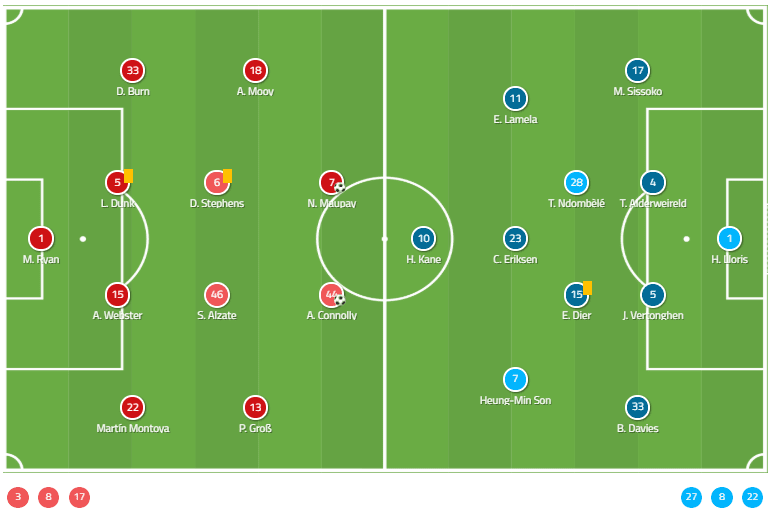
Pochettino went for what was considered Tottenham’s strongest 4-2-3-1 lineup. Hugo Lloris continued to be the first choice but he was forced to leave the field after three minutes. His attempt to save a shot from Pascal Groß ended with a harsh landing and he broke his left hand so eventually he was replaced by Paulo Gazzaniga later on.
In terms of before the match, the visitors didn’t have the service of the two new signings in Giovani Lo Celso and Ryan Sessegnon. They suffered a groin and thigh injury respectively and are only slated to return in late October. Serge Aurier was suspended for this match after he received a second yellow card against Southampton, so his replacement was Moussa Sissoko, who was converted into a right-back.
Spurs’ style of play
Statistically speaking, it’s quite surprising to see Tottenham struggling to create chances. Although they registered eight chances and managed to get three of them on target, those numbers are only half of what Brighton have done. Furthermore, the away side only had two chances in the first half, with Christian Eriksen came the closest from a long shot.
Having played through ninety minutes of the match, Harry Kane didn’t have his best day -he only got one chance and it was a close-range shot. At a distance where Tottenham’s fans thought he can create goals, he squandered the chance by striking it wide. Compared to substitute Lucas Moura, who only had seventeen minutes on the field, the Brazilian striker even put himself in two great chances. He made the most out of the opportunities that he had, forcing Mat Ryan to make great saves to keep Brighton’s clean sheet.

Moura’s first chance came from a situation where he utilised his movement to create space for his teammates. His decoy run dragged along Yves Bissouma and Dale Stephens, while Groß’s attention was put on Harry Winks. This allowed Eriksen to find Lamela in free space through a through ball.
Later on, Lamela laid it back towards the Brazilian player and he continued his dribble towards the 16-yard box. Using his technical abilities, it was possible for him to bypass Webster and Burn where his shot was also saved by Ryan in a 1 v 1 situation.
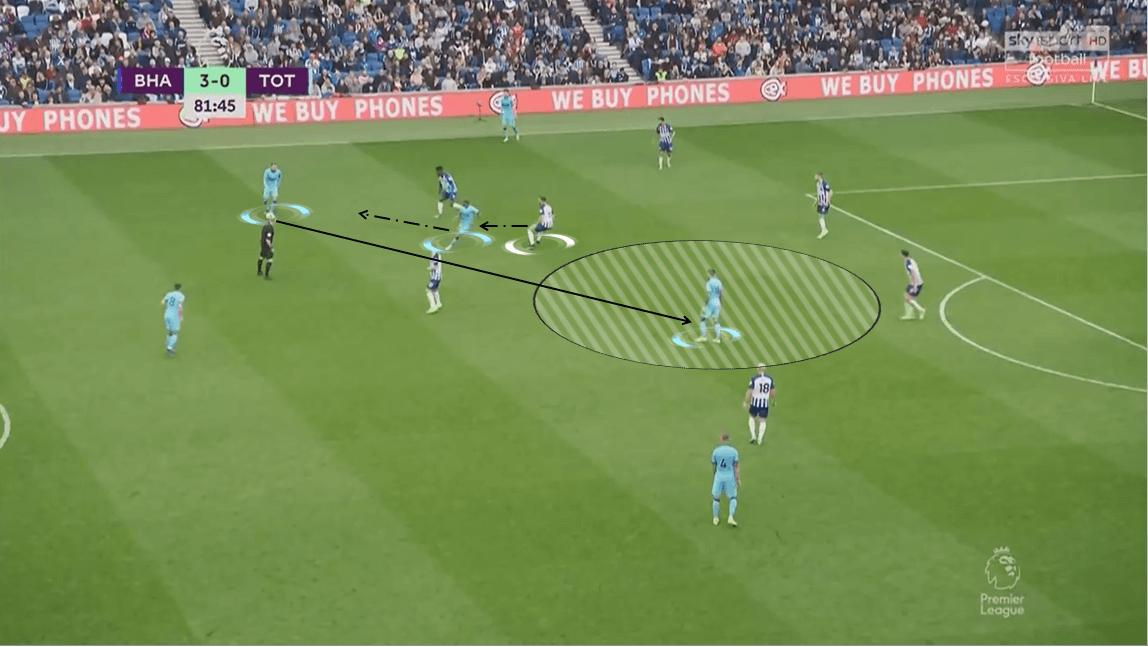
Moura’s chance was not the first time that Tottenham used this strategy to break down Brighton’s defensive structure. In the role of a complete forward, Kane tended to move flexibly in between the opposition’s defensive lines and created space for his teammates to move in. Moreover, he was also willing to drop deep to receive passes from the midfielders and carried it up the pitch.
This situation was something similar to the trait that he showed in the match. From his position, the England international dropped from his position to receive Toby Alderweireld’s direct pass. When he did so, Dunk followed his move and attempt to intercept the pass. Unfortunately, he left a big gap behind his back where Webster wasn’t able to fill in, which allowed Eriksen to make a run into that gap and turned up at the end of Kane’s pass.
Playing against a somewhat stubborn defensive juggernaut, it’s quite understandable for Tottenham to go for this strategy. Rather than being happy to circulate the ball inside the middle third and waiting for gaps to be opened, they opted to go for a more active solution. With three active attacking midfielders who were able to position themselves in pockets of space, the centre-backs were able to make penetrative passes to start the attack. Combined with Kane (and Moura), who usually used movements to disrupt the defensive lines, they were able to progress the ball into the final third more easily, though they lacked a very important factor to help them convert the chances. In a day where the likes of Kane, Eriksen, Moura and Lamela were all missing the precision in their shots, this was the reason why Tottenham couldn’t score a consolation goal.
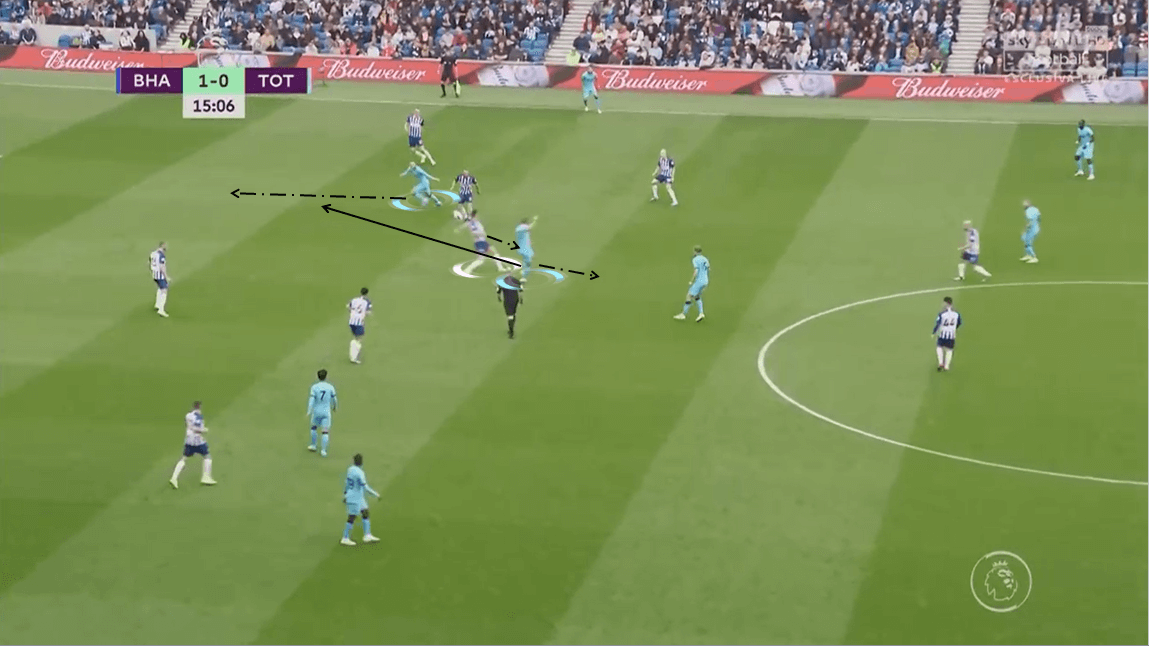
In defence, they started off creating a 4-1-4-1 defensive structure when they weren’t in possession. With two defensive lines, they aimed to create numerical superiority inside their half and prevented Brighton from progressing the ball into the final third.
Usually, former Lyon midfielder Tanguy Ndombèlè would push higher and form the midfield line. Along with three attacking midfielders, they pressed Brighton players inside the middle third and attempted to recover possession inside that area. Meanwhile, Eric Dier stuck to his position and took on the responsibility of screening the space in front of him and the defensive line. He would be more active in intercepting passes that came towards him, therefore, allowing Spurs to create a counter-attack.
Depending on which side Brighton used to create their attacks, Tottenham’s defensive line would shift towards it. The full-back on that side could stretch wide and became the focal point for the whole shape to move laterally across the pitch. He was the first player to reach the ball carrier and would apply pressure early while waiting for the support from his teammates.
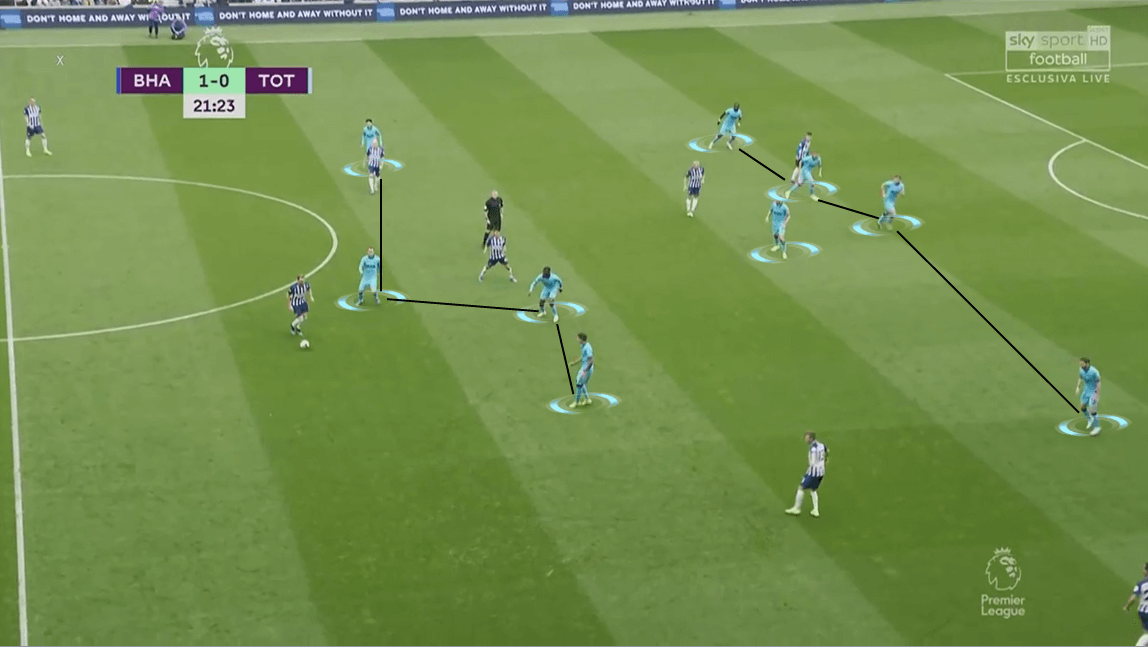
During the match, it’s quite easy to notice Tottenham used a compact defensive structure. They aimed to overload a certain area and prevented short combinations between the Brighton players. But it also allowed the home side to stretch their attacking shape wider and occupy both flanks.
While Mooy and Groß worked more inside the half-spaces, wing-backs Dan Burn and Martín Montoya could make overlapping runs up the pitch to fill in the wide areas. There, they were able to receive a long pass from the centre-backs and create a quick attack from either wing. With Tottenham’s defensive shape still shifting across, Brighton’s wing-back would have time to aim his cross towards a striker inside the box.
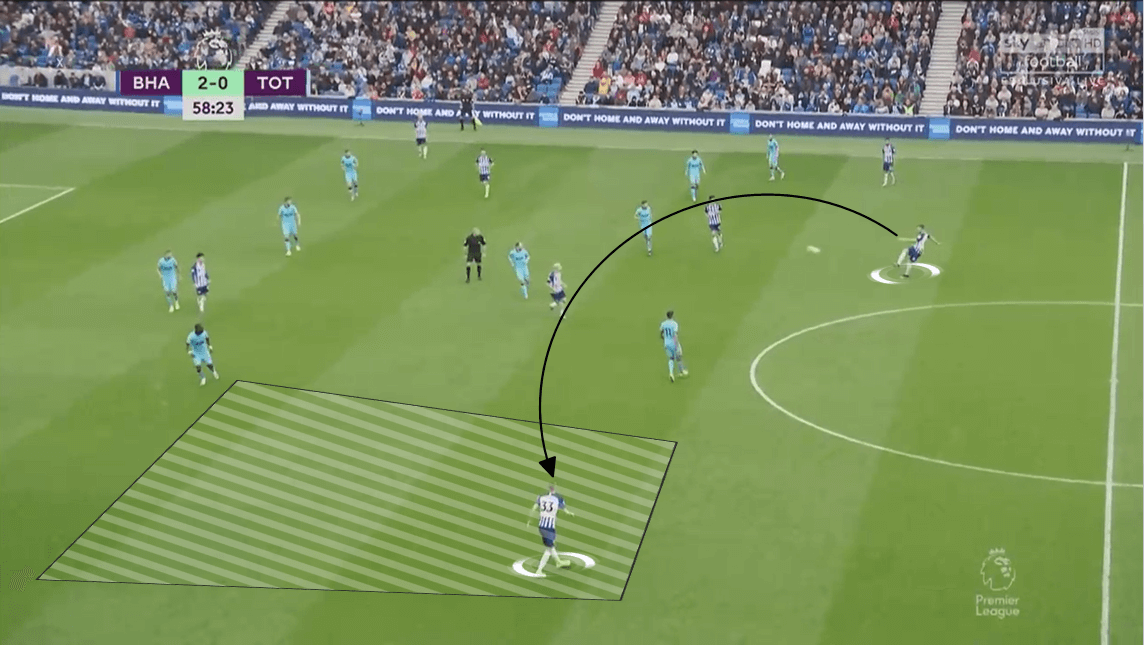
High up the pitch, they employed a conservative press and also used a narrow structure to disrupt Brighton’s build-up. The players intended to suffocate the ball carrier by eliminating spaces and possible passing options around him. This would force him to clear the ball out of the area and Tottenham’s centre-backs were on hand to recover possession for their team.
But there were some occasions where Kane was left alone in pressing Dunk and Webster. Not only was the English striker unable to tackle the ball, but it also decreased the efficiency of Tottenham’s pressing. In a 2 v 1 situation, Brighton’s centre-backs were able to circulate the ball among each other easily without facing any significant pressure from Kane. Therefore, the home side could progress the ball up to the middle third and found wing-backs or wingers using long passes into either flank.
In the second half, the visitors turned their formation into a back-five as Eric Dier dropped deep in between the centre-backs. They used similar principles with the defensive line pushed high up the pitch. Furthermore, Ndombèlè and Eriksen would screen the space in front of the line and provided support for his colleagues. They applied pressure on the ball carrier who attempted to attack the central space and recover possession for their upcoming attack.
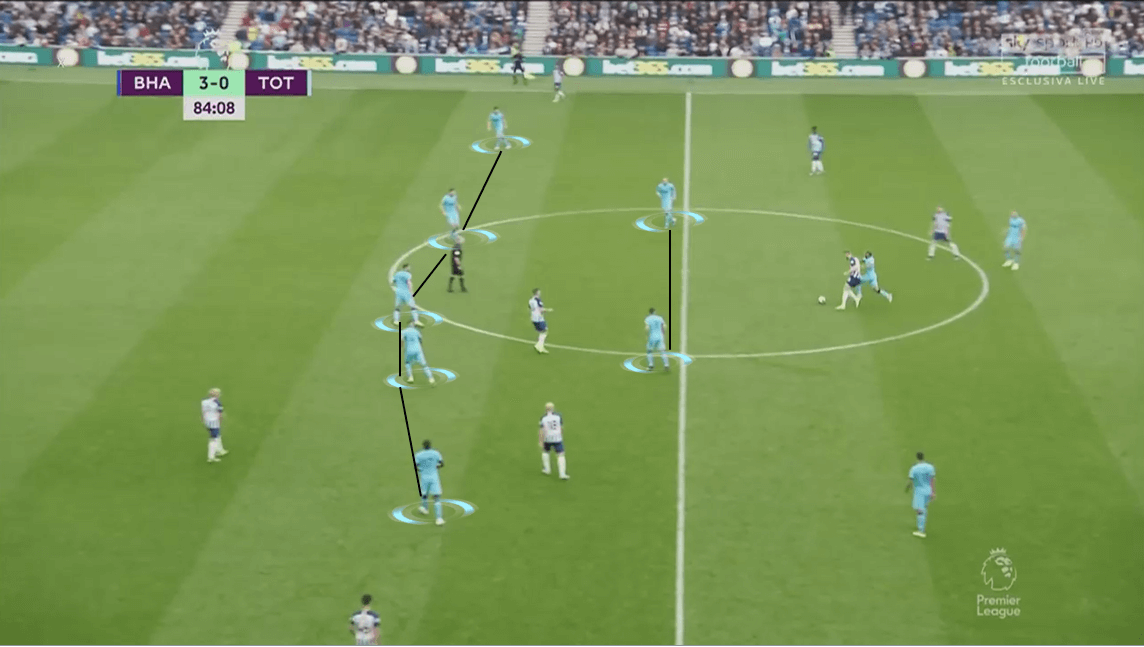
Brighton’s style of play
Rotating between a three-at-the-back and a four-man defence seems like a trend for Potter this season. In Burn, he has a centre-back who can also play as a left-back but with less attacking productivity. In a few matches this season, we have seen Burn staying back and tucked inside to create a three-man build-up inside Brighton’s half. With the fact that he is somewhat of a ball-playing defender, combining with Webster and Dunk to circulate and progress the ball up the pitch shouldn’t be a strange thing.
But in this match, though, he was given the license to roam more like an attacking full-back. As shown in the average position map below, he positioned himself further up the pitch along with two central midfielders. This allowed him to create a tight connection between himself and Mooy, or himself and Stephens.
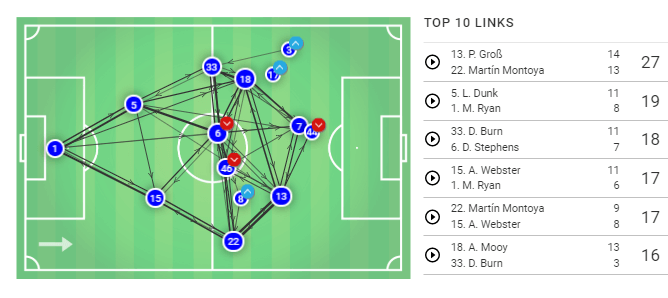
At times, we could see him making overlapping runs up the pitch and put in crosses for the strikers inside the box. The situation that led to Connolly’s first goal of the game was an example of his trait. As he found himself being under pressure of two Tottenham players, he still able to send a cross into the box for Connolly.
Meanwhile, the Irish striker positioned himself in between two centre-backs and without any significant pressure, he was able to receive the cross. Gazzaniga denied a spectacular backheel as he beat Ben Davies to approach the ball. Still, the Welsh defender’s tackle accidentally hit Connolly’s follow-up and made the situation hard for Gazzaniga to save it.
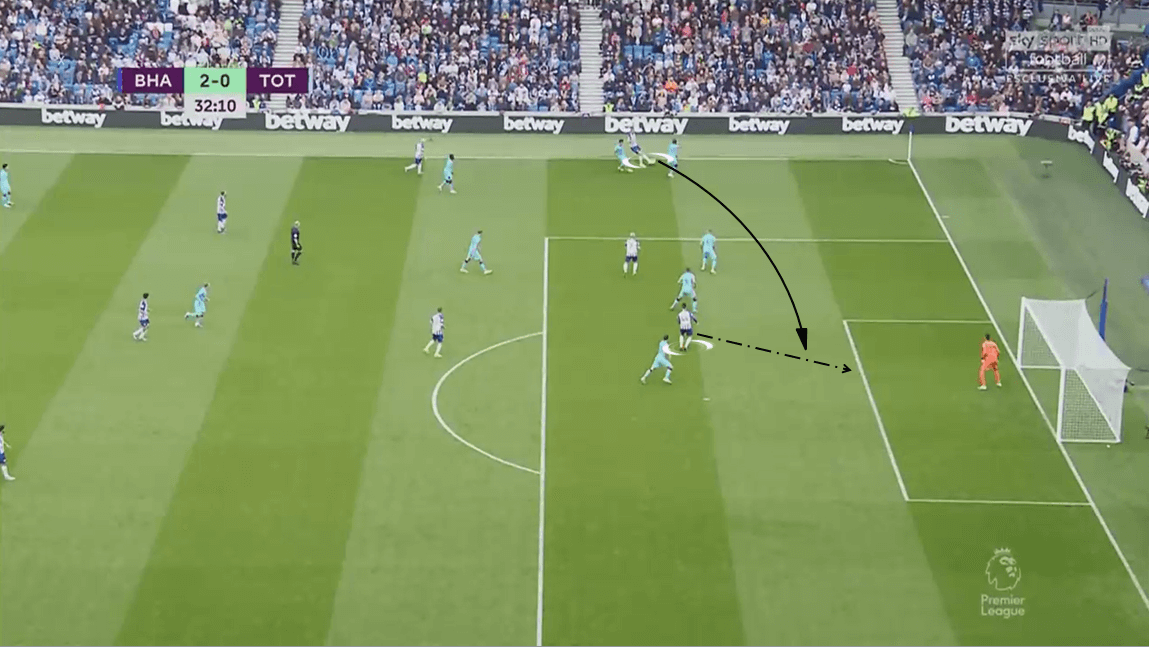
In general, it’s fair to say that Brighton had a very efficient day in creating chances towards Tottenham’s goal. While some of the chances were created through individuals efforts, the rest was from Tottenham’s defensive errors. Firstly, they capitalised on the fact that sometimes their opponent pressed high up the pitch. This meant they have to push their defensive line higher and leave the gap behind them unoccupied.
By bypassing the press through short combinations, it was possible for Brighton players to progress it into Tottenham’s half. In that case, the ball carrier would signal for support from the other midfielders and he also encouraged Maupay and Connolly to sit on the shoulder of defenders. In the situation below, the French striker opted to make a decoy run to attract the attention of Jan Vertonghen. With one defender already eliminated from the situation, Connolly was able to break through space in between the other two defenders to receive the through ball from Groß.
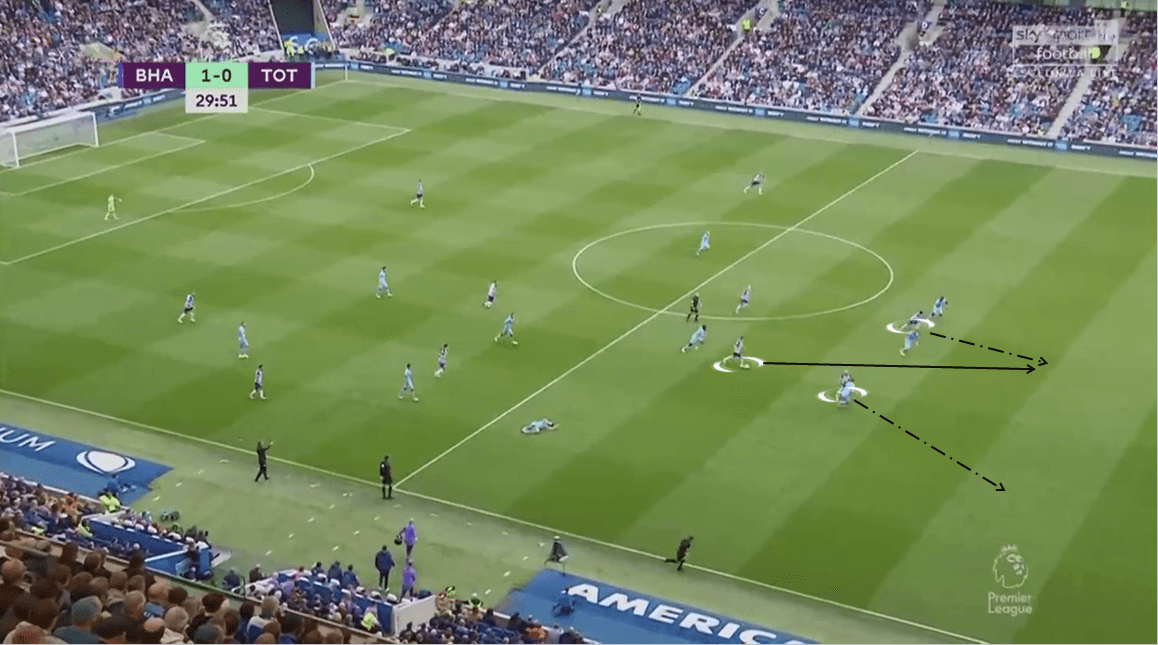
Secondly, they used long balls to attack the space behind Tottenham’s defensive line. From the build-up, Dunk and Webster could send the ball towards the strikers and allowed them to sprint towards the 16-yard box. Since the defenders pushed very high for their press, Connolly and Maupay had the option of positioning themselves at the halfway line and receive the pass while approaching the final third at the same time. This was the case when the former Luton loanee completed his brace in the second half.
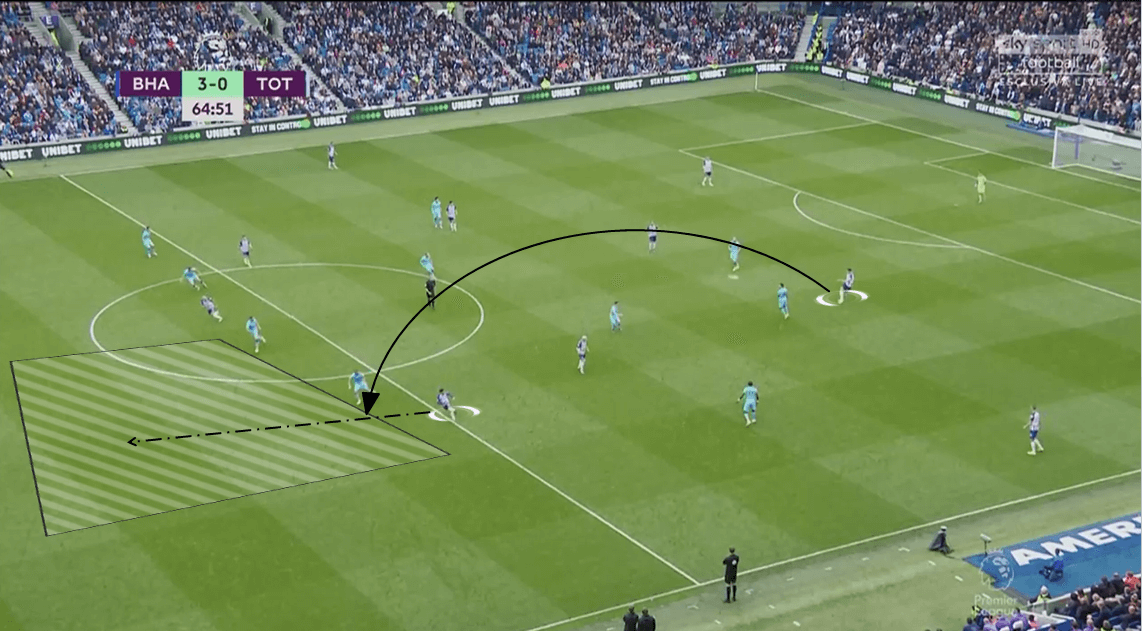
Defensively, Brighton were a stubborn team as they created a clear 4-4-2 defensive structure inside their half. The players were required to be disciplined and stuck to their respective positions in order to prevent Tottenham from exploiting gaps in between the defenders.
This may remind some fans of how Burnley used their disciplined defensive strategy and became one of the most solid teams at the back in a few seasons ago. Brighton employed similar tactics with the players focused on defending zone 14 and blocked shots that came from the opponent. They focused on keeping their shape narrow in front of the box while limiting the number of shots that came towards Ryan’s goal.
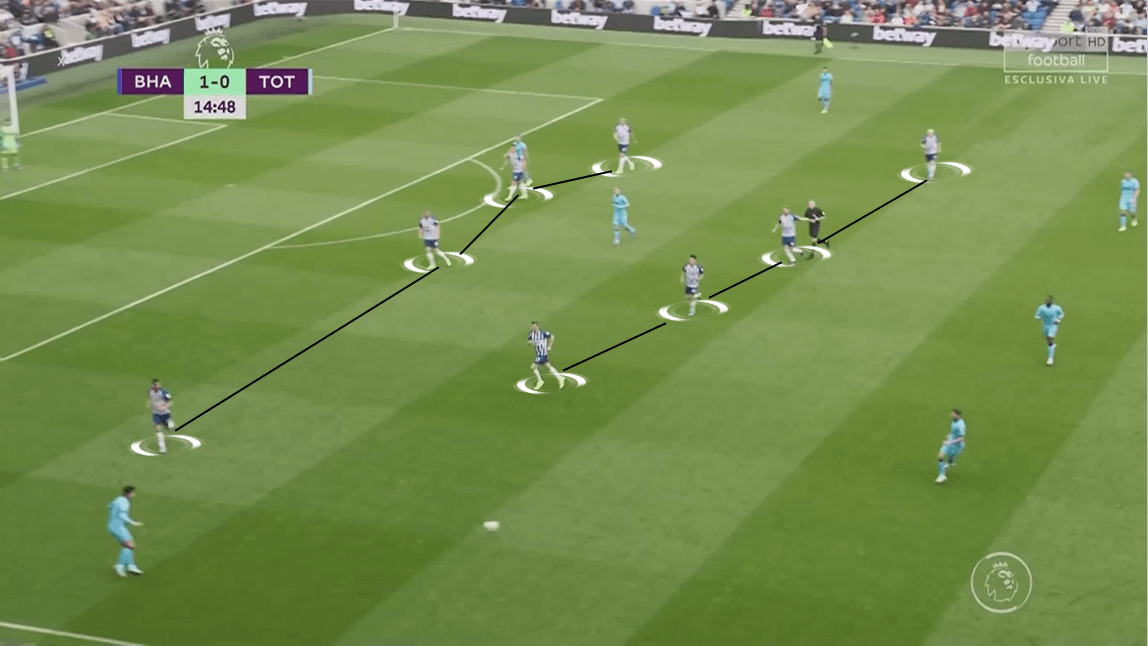
They also employed high-intensity pressing when they attempted to recover possession inside Tottenham’s half. Both strikers were the most active players as they tended to roam from their positions and followed Tottenham’s centre-backs. The aim was to tackle the ball away from their control for an easier approach to the 16-yard box.
Meanwhile, the midfielders also pushed high up the pitch and marked any of the players who attempted to turn himself into a possible passing option. They wanted to force the opposition to clear the ball up the pitch, where Dunk and Webster were able to clear it away. This was an effective strategy as Tottenham didn’t have much time holding the ball inside their half. Instead, they had to use quick and short combinations to progress the ball up the pitch with several of them being caught by Brighton players.
Conclusion
At the beginning of the match, Tottenham were thought to be the team who took control. They were determined to overturn the misfortune that saw them lose to Colchester and Bayern. With arguably the strongest lineup that Pochettino had chosen, it’s clear to see their intention of securing three points, but unfortunately for them, they faced a very stubborn Brighton who put an emphasis on being disciplined when showing their style of play.
That was one of the reasons, along with the fact that the London-based club didn’t enjoy much luck in front of goal. Eight chances compared to seventeen of Brighton’s – that’s a huge difference. On a day where most of their players underperformed and Lloris’ early injury, things didn’t go the way that Tottenham wanted. Huge credit goes to Potter and his Brighton side as they have shown a very attractive style of play and hit the visitors where they were the weakest. Although they had the tendency of rotating their formation and their tactics somewhat, the quality in their shots was what they needed to secure three points, and their strikers brought the exact thing that they were looking for.

If you love tactical analysis, then you’ll love the digital magazines from totalfootballanalysis.com – a guaranteed 100+ pages of pure tactical analysis covering topics from the Premier League, Serie A, La Liga, Bundesliga and many, many more. Buy your copy of the October issue for just ₤4.99 here





Comments